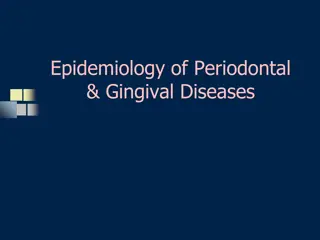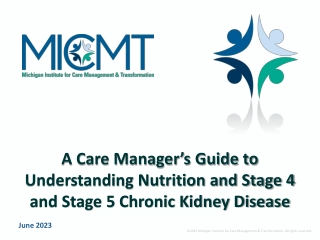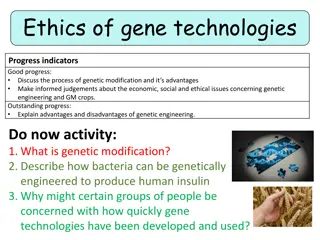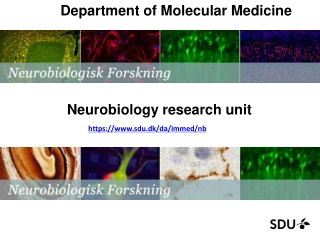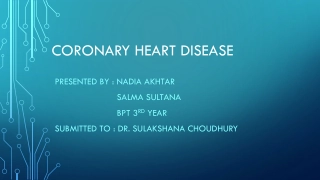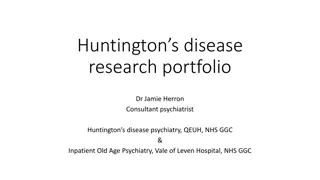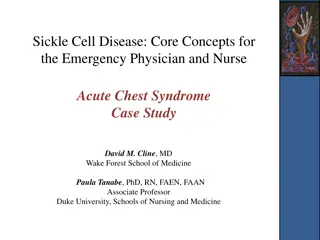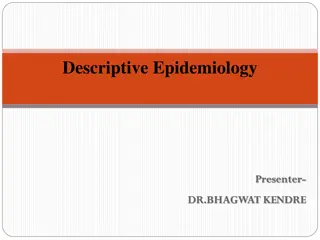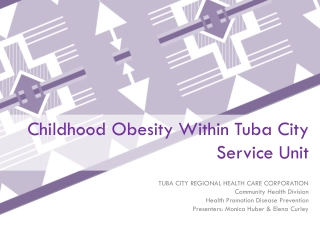Uncovering the Impact of Periodontal Disease on Health
Delve into the interconnected relationship between periodontal disease and mortality, coronary heart disease, stroke, diabetes, pregnancy, COPD, and acute respiratory infections to enhance awareness and understanding for better health outcomes.
Download Presentation
Please find below an Image/Link to download the presentation.
The content on the website is provided AS IS for your information and personal use only. It may not be sold, licensed, or shared on other websites without obtaining consent from the author. Download presentation by click this link. If you encounter any issues during the download, it is possible that the publisher has removed the file from their server.
Presentation Transcript
Learning objectives Focal infection theory revisited Periodontal disease and mortality Periodontal disease and coronary heart disease Periodontal disease and stroke Periodontal disease and diabetes Periodontal disease and prgnancy Periodontal disease and COPD Periodontal disease and acute respiratory infections
Periodontal disease is an inflammatory disease initiated by bacterial pathogens. Environmental ,physical ,social ,and host stresses may affect and modify disease expression through a multitude of pathways . Certain systemic condition can affect the initiation and progression of gingivitis and periodontitis .
Organ systems and conditions possibly influenced by periodontal infection 1)Cardiovascular and cerebrovascularsystems : Atherosclerosis Coronary heart disease Angina Myocardial infarction Cerebrovascularaccident Erectile dysfuction anemia 2]kidney diseases Renal insuffiency Chronic kidney diseases End stage kidney disease
6] Respiratory system Chronic obstructive pulmonary disease Acute bacterial pneumonia 3] Endocrine system Metabolic syndrome Diabetes mellitus 4] Reproductive system Preterm low birth weight infants Preeclampsia 7] Cognitive function Dementia Alzheimer disease 8] Cancers Colorectal Pancreatic Hapatocellular others 5] Autoimmune disease Rheumatoid arthritis Ankylosing spondylitis
Focal infection theory revisited William hunter ,a british physician ,first developed the idea that oral microorganisms were responsible for a wide range of systemic conditions. Extraction of teeth with these gingivitis and periodontitis helps to eliminate the source of sepsis . The focal infection theory fell into dispute in the 1940s and 1950s when widespread extraction ,often of the entire defination ,failed to reduce or eliminate the systemic conditions .
Periodontal disease and mortality Patient with poor periodontal health may also have other risk factors that increase mortality rates . Host susceptibility factors that predispose the patients to periodontitisalso predispose them to systemic conditions such as ischemic heart disease , stroke, respiratory infections May cause mortality if chronic low bacteremia persists
Periodontal disease and coronary heart disease Coronary heart disease and related events are a major cause of death . MI has been associated with acute systemic bacterial and viral infections ,and is sometimes preceded by influenza like symptoms . Localized infections chronic inflammatory reaction has been suggested mechanism underlying CHD in these individuals .
Study done by matillaet al found that MI patients had significantly worse dental health than did the controls This association between poor dental health and MI was independent of the known risk factor for heart disease such as age ,hypertention ,chlosterol levels diabetes. Periodontal infection may affect the onset or progression of atherosclerosis and CHD through certain mechanisms increasing viscosity of blood ,thrombus formation and embolization .
Factors affecting the blood viscosity Plasma fibrinogen Plasma lipoproteins White blood count Von willebrand factor Increase blood viscosity Increased viscosity of blood increase risk of thrombus formation ischemic heart disease and cerebrovascular accident
Effect of periodontal infection Ischemic heart disease IHD is associated with a process of atherogenesis and thrombogenesis
DAILY ACTIVITIES The exposure time to bacteremia from routine daily chewing and tooth brushing is much greater than from dental procedures . An estimated 8% of all cases of infective endocarditis are associated with periodontal or dental disease without a preceding dental procedure .
Thrombogenesis Platelet aggregation plays a major role in thrombogenesis . Most cases of acute myocardial infarction are precipitated by thromboembolism Oral organisms may be involved in coronary thrombogenesis i.e S .sanguisand P. gingivalis
Thromboembolism mechanism Oral pathogens steptococcussanguis and p.gingivalis Expression of platelateaggregation associated protein on some of strains Bacterial strains enters the circulation and aggregation of platelets Forms thromboemboli
Atherosclerosis It is a focal thickening of the arterial intima , the innermost layer lining the lumen of the vessel , and the arterial media , the thick layer under the arterial intimaconsisting of smooth muscle ,collagen ,and elastic fibers . Intimal lesion is called atheromaor atheromatousor fibro fatty plaques Enlarges gradually ,protrude into and obstruct vascular lumen
Periodontitisand atherosclerosis have many potential pathogenic mechanism in common Both have Complex causation Genetic and gender predisposition Share many risk factors ,most significant is smoking status Periodontitis , which is a chronic a chronic inflammation initiated by microbial plaque can predispose to atherosclerosis
Role of periodontal disease disease in MI or stroke Possible mechanism are ; Effects of infectious agents in atheroma formation Host mediated effects Common genetic predisposition for periodontal disease and atherosclerosis Common risk factors such as life style
Periodontal disease and stroke : Presence of systemic infection Production of acute phase reactant proteins (CRP & fibrinogen ) Hypercoagualable state decreased micro cerebral perfusion ,increased risk of thromboembolism Greater ischemia & more severe post ischemic neurologic defect
Periodontitis and diabetes DIABETES MELLITUS Chronic hyperglycemic state due to relative and absolute deficiency of insulin Hyposecrection of insulin or peripheral resistance of insulin impaired glucose uptake by the cells impaired glucose utilization chronic hyperglycemia Result into lipid and protein metabolism
Two types Type 1 diabetes mellitus (insulin dependent ) Type 2 diabetes mellitus (non insulin dependent ) Gestational diabetes
Mechanism of action of insulin Ingestion of food Secretion of insulin -ve Type I DM Glucose uptake through glucose transpoters through insulin dependent process Utilization of blood glucose -ve Type II DM Decreased blood glucose
COMPLICATIONS OF DIABETES MELLITUS Retinopathy Nephropathy Neuropathy Macrovasculardisease Altered wound healing Periodontal disease
Periodontitisand diabetes mellitus It is clear from epidemiological data that DM increase risk and severity of periodontitis . The increased prevalence and severity of periodontitis typically seen in patients with diabetes , especially those with poor metabolic control led to the designation of periodontal disease as sixth complication of diabetes
Effect of periodontal infection on glycemia Acute viral and bacterial infection have shown to increase insulin resistance and aggravates glycemic control . Systemic infection increases tissue resistance to insulin ,preventing glucose from entering into the cell causing elevated blood glucose level required increased amount of insulin to maintain normoglycemia.
Periodontal disease & pregnancy LOW BIRTH WEIGHT They are 40 times more likely to die in neonatal period than normal birth weight infants and account for two third of neonatal death . Infants who survive increased risk of congenital anomalies ,respiratory disorders and neuro developmental disabilities .
CAUSES OF LBW Preterm labor or premature rupture of membranes Smoking , alcohol or drugs use during pregnancy Inadequate prenatal care Race ,low socioeconomic status Hypertention ,diabetes High or low maternal age Genitourinary tract infection Maternal stress and genetic background Periodontal disease
Periodontitis and COPD CHRONIC OBSTRUCTIVE PULMONARY DISEASE Characterized by aieflowobstruction resulting from chronic bronchitis or emphysema Emphysema is a chronic enlargement of airways distal to bronchioles due to bronchiolar smooth muscles and elastic fiber destruction .
Chronic bronchitis is narrowing of airways proximal to distal bronchi due reactive hyperplasia of bronchial mucosglands and hypertrophy of muscles
RISK FACTORS OF COPD Cigarette smoking Industrial smoke tars Genetic conditions Presence of defective alpha 1 antitrypsin Defective alpha 1 antichymotrypsin Alpha 2 macroglobulin Vitamin d binding protein
Effect of periodontitis Neutrophil influx Release of oxidative & hydrolytic enzymes Tissue destruction Release of proinflammatorycytokines Recruitment of monocyte & macrophages
Acute respiratory infection The upper respiratory tract are often contaminated with organisms derived from oral ,nasal ,and pharyngeal region . Pnumonia is an infection of lungs parenchyma by bacteria ,virus ,fungi and or mycoplasma .
It is classified as 1 ) community acquired pneumonia 2)hospital acquired pneumonia
Community acquired pneumonia Caused by sreptococcus pneumonia and H.influenzae in individuals hospitalized 90 days or before for 2days or more . Caused by : Inhalation of infectious aerosol Aspiration of oropharyngeal organism Till now no association between periodontal disease and community acquired pneumonia has been found .
Hospital acquired pneumonia Gram veaerobic organism It is usually caused by the aspiration of oropharyngeal contents during esophageal reflux containing potential respiratory pathogens Potential respiratory pathogens may also originate in oral cavity ,dental plaque serve as a reservoir
Subgingival plaque harbor potential respiratory pathogens and periodontal pathogens, asociated with nosocomial pneumonia .



